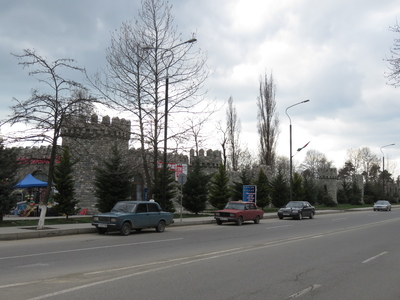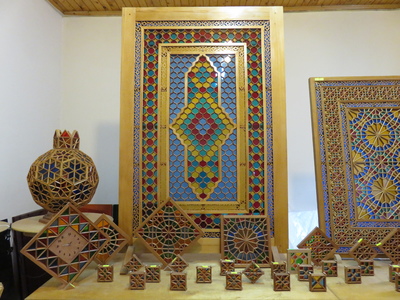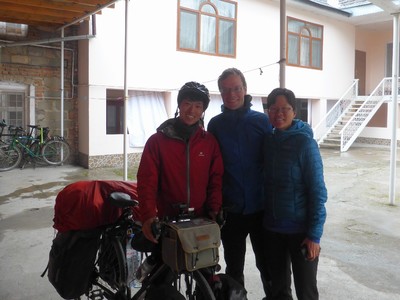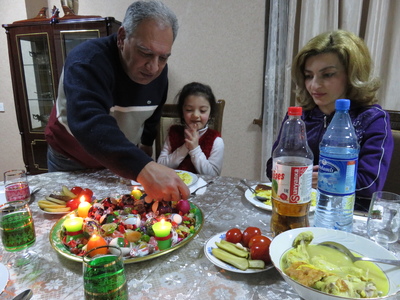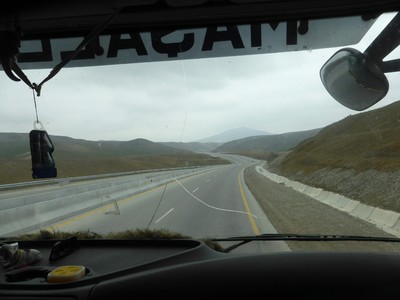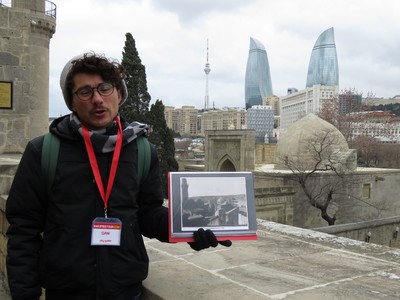Not just another Turkey
Posted on 2019-04-04
To be honest, we expected Azerbaijan to be quite boring. We had heard that the culture was very similar to Turkey, so that would not be new to us, and furthermore there wasn't much to see there. So our initial plan was just to zoom through the country as fast as possible on the flat roads across the steppe that cover much of the country. We even considered skipping the capital, Baku...
Fortunately, it all turned out quite differently. We did feel reminded of Turkey, with the similar languages, warm friendly people, and abundance of çay. However, three differences were immediately noticeable: People speak Russian as a second language; neighbourhoods are often enclosed in fancy-looking walls, often made to look like castle walls, so that in many small towns, we actually could not see much of the houses from the main road; and there were so many old Lada cars on the roads!
We were blessed with good weather on the first two days, as we cruised down a small, new road between the foothills of the Greater Caucasus mountain range on our left, and the vast flatlands of central Azerbaijan on our right. We found a nice, forested campsite on our first night, and after waking up to the songs of the birds, we made our way to the regional capital, Sheki (Şəki).
Cycling along the foothills of the Greater Caucasus mountains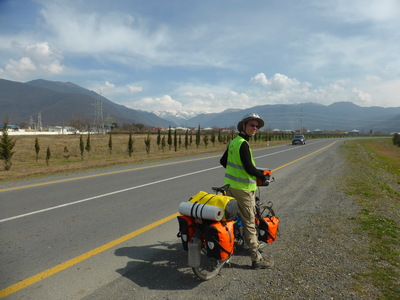
Sheki is one of the few places of touristic interest in Azerbaijan (outside of Baku), its highlights being the old town, the caravanserais, and the Palace of the Sheki Khans. The palace is modest in size, but its interior walls are covered with intricate murals, and its windows are one of the best examples of 'shebeke' art, where pieces of stained glass are held together in a delicate wooden lattice without any glue or nails.
We initially only planned one rest day in Sheki, but as the rain started and refused to stop, we became stuck for a few more days. Lucky for us, this allowed Kanji, a Japanese cyclist we met at the Iranian Embassy in Tbilisi, to catch up with us, delivering precious cargo: Heiko's rain jacket, that he had accidentally left behind in Tbilisi.
Our delay also led to us celebrating Novruz, the traditional New Year in Azerbaijan and Iran, at our hostel in Sheki. As dusk fell on the evening before Novruz, our hostel owner lit a big bonfire in his courtyard, and many of his friends and neighbours came over to enjoy the fire, and when it became smaller, to jump over it. According to tradition, jumping over the fire is believed to burn away the hardships of the past year. After that, we enjoyed a simple Novruz dinner in the hostel. Novruz is traditionally a family event, but our hostel owner's children are all overseas, so together with his housekeeper and her daughter, we became part of the family that night. It surprised us how some Novruz traditions match the pagan traditions we often associate with Easter: Bonfires are also lit for Easter in Germany, and colourful eggs are also prepared and eaten during Novruz.
When the weather cleared up again, we changed our minds and decided to take the more hilly, but also more scenic, road to Baku, instead of the flat and busy highway across the steppe. The climbs were tough at times, but we were rewarded by impressive views of the mountains.
Shamakhi (Şamaxi) is the last big town on this road before a long 120km stretch through an increasingly desert landscape to Baku, and we initially planned to camp a night to break this stretch into two. However, when we arrived in Shamakhi, we saw a storm forecasted for the following night, with rain and winds of up to 70km/h. Not wanting to be caught in the storm in the middle of the desert, we decided to hitchhike in order to make it to Baku in one day. Originally, we only wanted to hitchhike part of the way, to Gobustan Maraza, from where the road is mostly downhill, but the driver who picked us up was heading for Baku anyway, so we decided to be lazy and stayed on the truck all the way.
In Baku, we caught up with Kanji again, who was now staying in the same hostel as two French cyclists that he had met when leaving Sheki. They had cycled together to Baku, arriving two days earlier, but were waiting for the storm to pass before leaving the city. The next day, we took yet another free walking tour that took us around the fascinating Old City of Baku. We then spent the rest of the day on a surprisingly difficult search for a new canister of camping gas, which took us across much of the city.
We would have stayed another night, but the weather was perfect, so the next day, we joined Kanji and the French cyclists to Gobustan (Qobustan), south of Baku, where there are prehistoric rock carvings and mud volcanoes. We first tried taking a small road there, but once we turned off the paved road, we quickly got horribly stuck in the mud. After struggling for more than an hour, we decided that the effort was not worth the reward, and backtracked to the main highway instead. In Gobustan, we camped together in a very scenic spot, and parted ways in the morning (for now). Maybe we will meet again in Iran!
Our group cycling through the desert near Lökbatan, just outside Baku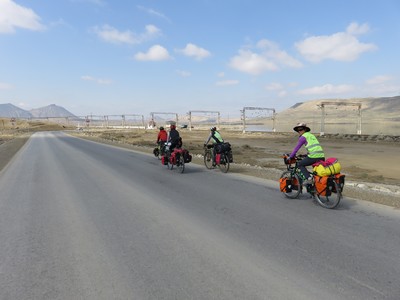
Unfortunately, Heiko picked up a stomach bug on the way to Gobustan, and after a terrible night, he could barely drag himself to the rock carvings the next day. Nevertheless, he insisted on entering the site, since we were already there, and Hannah did most of the seeing. The rock carvings, or petroglyphs, of Gobustan were created over many millennia, between 15000 BC and the middle ages, by homo sapiens and neanderthals who lived there in prehistoric times. The carvings may look cartoonish, but it is mind-boggling to realise how old these petroglyphs are and to imagine the lives of the people that created them.
Rock carvings at Gobustan National Park showing a boat and hunters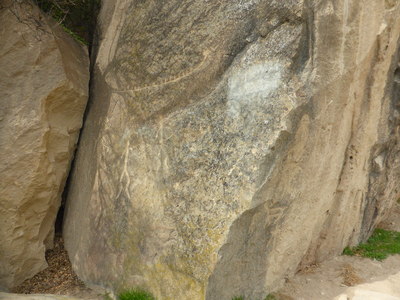
When Heiko finally recovered after two days, we went to see the mud volcanoes. Mud volcanoes are similar to normal volcanoes, but instead of lava, mud comes out on top. About half of the world's mud volcanoes are located in Azerbaijan. We had seen a big one from the road before, with mud flowing down its slopes, but this time, we went up another one where there are several active mini-volcanoes in what looks like the inactive top of a big one. It was quite curious to be able to stand next to the small craters and watch the mud bubble around and sometimes flow out. Hannah regrets not touching the mud, which is reportedly good for face masks... but it was muddy!
The following few days were quite unspectacular, as we had to cross the vast flatland steppe in central Azerbaijan to get to the south of the country. We mostly had tailwind and travelled super fast along the flat, straight, and boring highway, with nothing to see but grassland on both sides. It also started raining more and more the further south we went, so we were glad to make a quick escape from the country.
